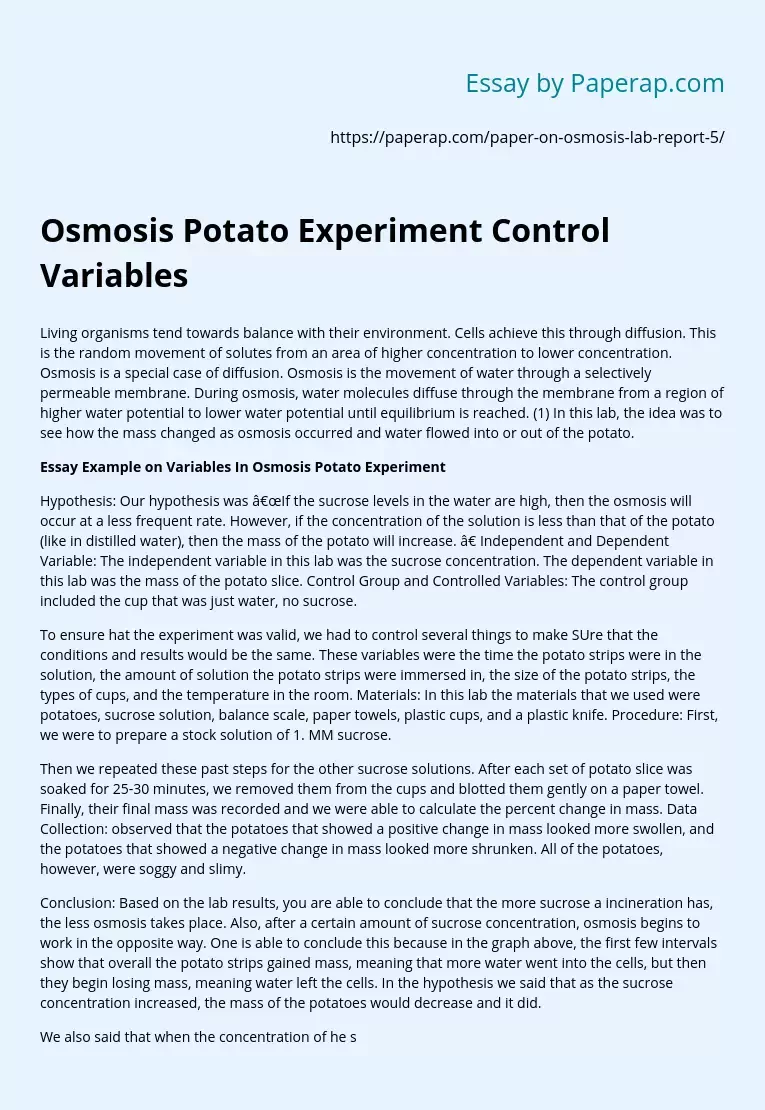Living organisms tend towards balance with their environment. Cells achieve this through diffusion. This is the random movement of solutes from an area of higher concentration to lower concentration. Osmosis is a special case of diffusion. Osmosis is the movement of water through a selectively permeable membrane. During osmosis, water molecules diffuse through the membrane from a region of higher water potential to lower water potential until equilibrium is reached. (1) In this lab, the idea was to see how the mass changed as osmosis occurred and water flowed into or out of the potato.
Essay Example on Variables In Osmosis Potato Experiment
Hypothesis: Our hypothesis was “If the sucrose levels in the water are high, then the osmosis will occur at a less frequent rate. However, if the concentration of the solution is less than that of the potato (like in distilled water), then the mass of the potato will increase. ” Independent and Dependent Variable: The independent variable in this lab was the sucrose concentration.
The dependent variable in this lab was the mass of the potato slice. Control Group and Controlled Variables: The control group included the cup that was just water, no sucrose.
To ensure hat the experiment was valid, we had to control several things to make SUre that the conditions and results would be the same. These variables were the time the potato strips were in the solution, the amount of solution the potato strips were immersed in, the size of the potato strips, the types of cups, and the temperature in the room.
Materials: In this lab the materials that we used were potatoes, sucrose solution, balance scale, paper towels, plastic cups, and a plastic knife. Procedure: First, we were to prepare a stock solution of 1. MM sucrose.
Then we repeated these past steps for the other sucrose solutions. After each set of potato slice was soaked for 25-30 minutes, we removed them from the cups and blotted them gently on a paper towel. Finally, their final mass was recorded and we were able to calculate the percent change in mass. Data Collection: observed that the potatoes that showed a positive change in mass looked more swollen, and the potatoes that showed a negative change in mass looked more shrunken. All of the potatoes, however, were soggy and slimy.
Conclusion: Based on the lab results, you are able to conclude that the more sucrose a incineration has, the less osmosis takes place. Also, after a certain amount of sucrose concentration, osmosis begins to work in the opposite way. One is able to conclude this because in the graph above, the first few intervals show that overall the potato strips gained mass, meaning that more water went into the cells, but then they begin losing mass, meaning water left the cells. In the hypothesis we said that as the sucrose concentration increased, the mass of the potatoes would decrease and it did.
We also said that when the concentration of he solution was less than the concentration of the potato, the mass would increase, and we can see an increase in mass for concentrations of 0. 0 M sucrose (distilled water), 0. 2 M sucrose, and 0. 4 M sucrose. From this, we can conclude that the potato has a sucrose concentration of greater that 0. 4 M. Osmosis occurs when there is a concentration gradient, and water flows from a high to low concentration. In solutions that had no sucrose, there are high concentrations of water, especially when compared to a potato, so water would go into the potato.
While solutions with high sucrose concentrations had low water concentration, and so water would leave the potato and try to balance the amount of sucrose. The method of this experiment had a few issues, especially because we had to change parts of the procedure to adapt to the classroom setting. Instead of each group testing five of their won potato slices, we shared answers. This caused problems and limitations because each potato slice may have been very different in size, causing there to be different rates of osmosis.
Osmosis Potato Experiment Control Variables. (2019, Nov 27). Retrieved from https://paperap.com/paper-on-osmosis-lab-report-5/

